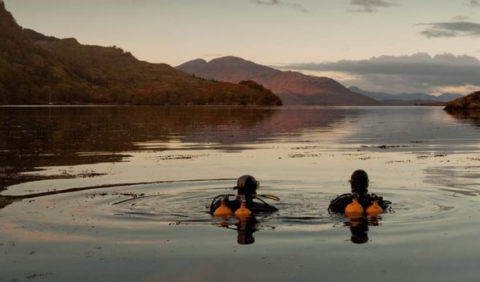Productive seas
Headline facts
Marine fish capture in Scottish waters was 486,000 tonnes in 2018 an increase from 330,000 tonnes in 2008.
Scottish Government, Sea Fisheries Statistics (2018)
Scottish tourism as a whole was estimated to be worth £4.1 billion in Gross Value Added (GVA) in 2017. Marine tourism is estimated to account for around 14% of all Scottish tourism.
Scottish Government (2019)
In 2017 Scotland’s Marine Economic Statistics reported that marine tourism generated £594 million GVA and employment for 28,300 people (headcount).
Scottish Government (2019)
In 2018, 12% of Scots visited the Scottish coast or sea for work or business.
Marine Scotland (2020)
81% of Scots believe that ports and harbours are important to Scotland, while 82% of Scots believe that coastal tourism / recreation and cruises are important to Scotland.
Marine Scotland (2020)
Juvenile queen scallops show strong preference for inhabiting live maerl compared to impacted dead maerl or gravel.
Kamenos, Moore & Hall-Spencer (2004)
Mussel farming relies entirely on natural food supplies (plankton). A blue mussel can filter 3 litres of seawater per hour.
Smaal & Van Stralen (1992)
There are many marine industries that benefit from the natural resources and ecosystem functions of the sea, supporting jobs and revenue both directly and indirectly. Many coastal communities benefit, but the financial gain also flows through Scotland’s towns and cities. Some key sectors are highlighted below, but many others also exist (e.g. fish processing, renewable energy, waste disposal and waste water treatment).
Fisheries
Although across the years 2016 to 2018 the tonnage of fish caught in all sea regions adjacent to Scotland by all UK vessels and by foreign vessels into the UK has remained relatively static at around 490 thousand tonnes, while the value in cash prices has increased to £650 million in 2018, the pelagic sector being the most valuable. The capture of wild fish and shellfish, and ultimately the fish processing industry which employed 7,700 people in 2017, is directly dependent on there being populations of those species that have the capacity to reproduce and maintain an effective breeding population after a proportion have been removed through fishing and natural mortality. Equally important is the dependence of the fishing industry on the condition of the habitats upon which fish and shellfish rely. Some target species have particular habitat associations (e.g. Nephrops with muddy sediments), while other species (e.g. cod) make use of a range of habitats. Complex habitats such as maerl, mussel beds, rocky reefs and seagrass meadows are known to have particular value for juveniles and spawning adults of some species. Maerl and flame shell beds, for example, often support large numbers of juvenile scallops. Gravel beds are important for spawning herring. Coarse sand habitats are important for sandeels, which are an important prey source for various commercial fish species and seabirds such as kittiwakes. For fisheries products to be fit for human consumption, it is also important for the water and sediments to be clean; mussels and clams from lower quality waters can be depurated (i.e. purified in clean water holding tanks), but waters in good environmental condition provide this service for free.
Aquaculture
Sustainable and good-practice fish farming requires waters that are clean and well-flushed by currents or tides, a service provided by the local hydrological conditions. The conditions in Scotland’s sea lochs and voes on the west coast, the Western Isles, Orkney and Shetland are such that the Atlantic salmon industry had a production value of £878 million pounds in 2018. In addition, between 2013 and 2017, the aquaculture GVA increased by 58% from £224 to £354 million, with employment increasing by 20%. Human activities do result in impacts on marine systems. Aquaculture (finfish and shellfish) activities can, for example, be associated with 25 marine pressures. However, recovery of sedimentary benthic habitats from the impacts of fish farms is aided by naturally occurring sediment re-worker species that help to breakdown waste. This can only happen where waste inputs do not exceed the natural capacity for this function. Healthy and diverse habitats may also be less susceptible to diseases that can sometimes arise in association with animal husbandry, but again there are limits to these natural functions. Animal husbandry within lochs or open seas, for example shellfish farming, benefits from its location in healthy and diverse habitats, lessening disease transmission either directly or in reducing associated stress factors. Seaweed cultivation requires clean coastal waters which enables adequate light penetration to allow photosynthesis, made possible by local hydrological conditions. In addition, sufficient nutrients are required, a service provided by naturally occurring marine processes.
Work is underway to improve the sustainability of protein-sources being used to produce feed for farmed salmon. Currently, much of this feed comes from wild-caught fish, some explicitly targeted for the purpose and some from bycatch. As such, the viability of the salmon farming industry is currently dependent on the sustainability of some fisheries, including those beyond UK waters.
Tourism and recreation
Marine and coastal tourism are an increasingly important feature of the rural and national economy of Scotland generating £594 million Gross Value Added (GVA) and employment for 28,300 people in 2017. Many visitors are attracted by wildlife and scenery, but the recreational opportunities such as North Coast 500 and quality of life associated with the coast are also a reason for living and working near the sea. The wildlife, generally good water quality, scenic qualities, cultural heritage and accessibility of marine and coastal ecosystems underpin much of the success of commercial opportunities, from wildlife watching to eco-tourism, angling and food-tourism. These benefits also extend to the passenger transport industry (ferry-services carried 10.3 million passengers in 2018), which can market themselves as opportunities for enjoying Scotland’s coastal and island scenery and marine wildlife.





